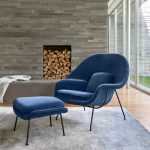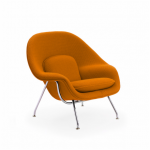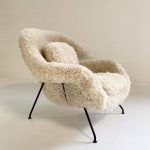The womb chair remains one of the most famous representations of mid-century modernism. The neo-futuristic, organic shape of the Womb Chair stands for sublime elegance. Despite the fact that the chair looks like a masterpiece of modern art, it is fully functional and very comfortable.
story
The design of the Womb Chair was created by Eero Saarinen, a legendary Finnish-American architect and industrial designer, and Florence Knoll, an American architect and furniture designer who studied under the supervision of the legendary Mies van der Rohe. The history of their collaboration on the chair goes back to the early 1940s, when Saarinen received a briefing from Knoll that said, “I want a chair that is like a basket full of cushions to roll up and a book read.”
Needless to say, he rose to the challenge. However, Saarinen, always fascinated by materials and shapes, strove to achieve the comfort of sitting through the shape of the chair, rather than the depth of its upholstery. The final draft came into the spotlight in 1946. Well received by critics and the general public, the Womb Chair was an instant hit. It is still commercially available and has been made under the Knoll brand since 1948.
design
“I designed the Womb Chair because it seemed like a large and very comfortable chair had to take the place of the old overcrowded chair. Today we need to relax more than ever. “This quote from Eero Saarinen in 1948 fully takes into account the fact that the Womb Chair was designed to provide maximum comfort to its users. The shape of the chair is adapted to the curvature of the human body. Before Saarinen achieved the ideal shape that would not prevent the user from assuming a variety of positions, he had worked on a number of different prototypes and scale models. He developed the one-piece shell that curves around the person sitting in it and gives the chair its famous cozy, intimate feeling and a feeling of security – hence the name “The Womb Chair”. The refined shape of the bowl required the use of new materials and advanced manufacturing processes, which were still in their infancy in the 1940s. Saarinen’s material of choice was the composite of fiberglass and resin, which could be brought into the desired shape. After a long and careful search, Eero and Florence found a New Jersey boat builder who was experimenting with the fiberglass and resin composite. They managed to convince him to take part in the manufacture of the Womb Chair. Florence Knoll later recalled: “The boat builder was very skeptical at first. We just asked him. I think we were so young and so excited that he finally gave in and started working with us. We had a lot of problems and failures until they finally got a chair that would work. “
The high level of comfort is due to the high-density foam, which is then covered with the KnollTextiles fabric upholstery, which is available in three different versions: Classic Bouclé (52% wool, 48% nylon), Cato (86% wool, 14% rayon) and Sonett (100% polyester). Although “a basket full of cushions” was mentioned in the original review, the actual chair only has two cushions on the seat shell and the backrest. The bowl is attached to the four-legged base, which consists of bent steel rods and is fitted with stainless steel and nylon glides at the ends. The base is provided with the chrome coating. In order to achieve the absolute heights of comfort and relaxation, customers can combine the womb chair with the matching ottoman. The ottoman is made using the same materials and processes and is a perfect addition to the chair.
In summary, it can be said that the iconic design by Saarinen and Knoll not only meets the physiological needs, but also appeals to the most sublime taste of every esthete. Its innovative, futuristic design, combined with the impeccable quality of workmanship, has given the chair a very special place in the history of interior design.
 decorafit.com Design ideas for your home and patio
decorafit.com Design ideas for your home and patio












